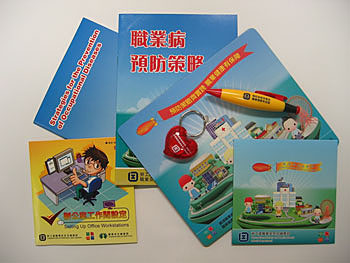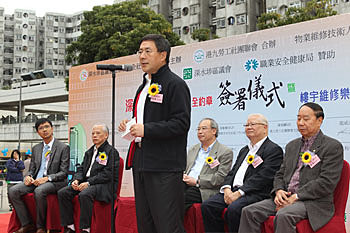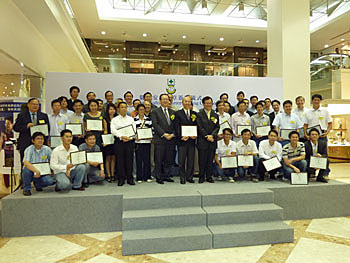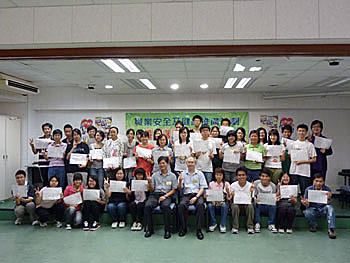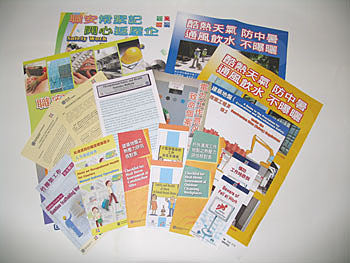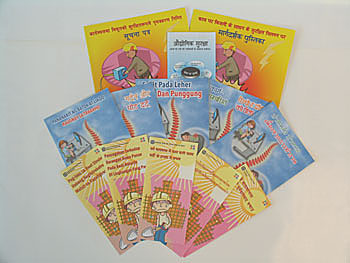Chapter 4 Safety and Health at Work
The Programme of Safety and Health at Work
www.labour.gov.hk/eng/osh/content.htmThe Occupational Safety and Health Branch is responsible for the promotion and regulation of safety and health at work. The objective of the Programme of Safety and Health at Work is to ensure that risks to people's safety and health at work are properly managed and reduced to the minimum through the three-pronged strategy of legislation and enforcement, education and training, as well as publicity and promotion. More specifically, we achieve the objective by:
- providing a legislative framework to safeguard safety and health at work;
- ensuring compliance with the Occupational Safety and Health Ordinance (OSHO), the Factories and Industrial Undertakings Ordinance (FIUO), the Boilers and Pressure Vessels Ordinance (BPVO) and their subsidiary regulations by conducting inspections and taking out regulatory actions;
- investigating accidents and occupational health problems at workplaces;
- providing to employers, employees and the general public appropriate information and advice to promote knowledge and understanding of occupational safety and health; and
- organising promotional programmes and training courses to improve safety awareness of the workforce.
The Labour Department establishes the legislative framework to safeguard safety and health at work. The principal legislation for safety and health at work includes the OSHO, the FIUO, and the BPVO.
With few exceptions, the OSHO protects employees' safety and health at work in practically all branches of economic activities. It is a piece of enabling legislation that empowers the Commissioner for Labour to make regulations prescribing standards for general working environment as well as specific safety and health aspects at work.
The FIUO regulates safety and health at work in industrial undertakings, which include factories, construction sites, cargo and container handling areas, as well as catering establishments.
The BPVO aims at regulating the standards and operation of equipment such as boilers, pressure vessels, including thermal oil heaters, steam receivers, steam containers, air receivers and pressurised cement tanks mounted on trucks or trailers.
Our Work and Achievements in 2010
Work Safety Performance
Through the concerted efforts of all parties concerned, including employers, employees, contractors, safety practitioners, and the Government and public sector organisations, Hong Kong's work safety performance has been improving since 1998. The improvement in the construction industry was especially remarkable.
The number of occupational injuries in all workplaces in 2010 stood at 41 907, representing a drop of 22 per cent from 53 719 in 2001, while the injury rate per thousand employees decreased to 15.5, down by 28.1 per cent when compared to 21.6 in 2001. The number of industrial accidents for all sectors went down to 14 015, representing 50.9 per cent drop when compared to 28 518 in 2001. The accident rate per thousand workers for all sectors in 2001 and 2010 were 44.6 and 24.9* respectively.
*The compilation of the accident rate per 1 000 workers of all industrial sectors in 2010 is based on the employment size classified under Hong Kong Standard Industrial Classification Version 2.0 (HSIC V2.0) which is different from those under HSIC V1.1 in previous years. Therefore, this accident rate cannot be strictly comparable to those published in previous years.
The number of industrial accidents in the construction industry decreased significantly by 68.7 per cent, from 9 206 in 2001 to 2 884 in 2010, while the accident rate per thousand workers also decreased from 114.6 to 52.1, down by 54.5 per cent.
Occupational Diseases
In 2010, there were 229 cases of confirmed occupational disease. Compared with 430 cases in 2001, this represented a substantial drop in the number of occupational disease cases in the past 10 years. Occupational deafness, silicosis and tenosynovitis of the hand or forearm were the most common occupational diseases in the year.
For more statistics on occupational safety and health, please visit the webpage: www.labour.gov.hk/eng/osh/content10.htm
Key Indicators of Work
Some key indicators of work of this programme area are shown in Figure 4.1.
Enforcement
To ensure safety and health at work, we inspect workplaces, monitor health hazards, investigate work accidents and occupational diseases, register and inspect boilers and pressure equipment and advise on measures to control hazards or prevent accidents.
A key element in enforcement is to give advice on the prevention of accidents. We conduct promotional visits to encourage employers to proactively adopt a self-regulatory approach in managing risks at the workplace. We also conducted regular enforcement inspections to various workplaces to ensure that duty-holders had observed all related statutory requirements stipulated in safety legislation. In 2010, we conducted 13 special blitz operations targeting various high-risk work activities, including construction safety, safety of renovation and maintenance works, scaffolding safety, fork-lift truck safety in waste recycling industry, catering safety, cargo and container-handling safety as well as fire and chemical safety. Some of these blitz operations were conducted not only on normal working days but also at night and during holidays to detect and clamp down on unsafe acts. In these 13 operations, a total of 24 050 workplaces were inspected, with 457 improvement notices and 16 suspension notices issued, and 507 prosecutions initiated.
We continued to place establishments with poor safety performance under close surveillance. Improvement notices or suspension notices were issued when necessary to secure a speedy rectification of irregularities, or to remove imminent risks to lives and limbs. To handle workers' complaints on work safety more effectively, our Central Inspection Team conducts independent investigation into complaints lodged by workers and encouraged workers to report unsafe conditions or malpractices in workplaces. In 2010, the team handled 151 complaints and initiated four prosecutions arising from investigation of these cases. We also enhanced the intelligence reporting system on unsafe RMAA works with the Hong Kong Association of Property Management Companies. In 2010, a total of 490 enquiry/complaint/referral cases were received through the system and other channels. As a result of the follow-up inspections on these cases, we issued 64 suspension/improvement notices and took out 51 prosecutions. We had also established a similar referral mechanism with the Housing Department. In 2010, we received through the mechanism a total of 3 360 notifications of high risk RMAA works in public housing estates and followed up on these referrals.
The first case of human swine influenza A/H1N1 was confirmed in May 2009 in Hong Kong. Upon elevation of the response level under the Framework of Government's Preparedness Plan for Influenza Pandemic to "Emergency Response", we activated our departmental mobilisation plan immediately to step up inspections of workplaces at a higher risk of infection to ensure adequate infection control measures to safeguard the health of employees. During that period, we inspected all 53 public and private hospitals, two slaughterhouses, 11 boundary control points, 83 General Outpatient Clinics under the Hospital Authority and Tuberculosis and Chest Clinics under the Department of Health, 506 elderly homes, 13 pig farms, 100 workplaces of cleansing contractors, 96 schools suspended due to outbreak of the infection, and 3 900 restaurants. A total of 424 warnings and 17 improvement notices were issued. With the lowering of the response level to "Alert" in May 2010, we resumed normal inspections of those workplaces accordingly.
From April to September, the department stepped up its enforcement, while enhancing publicity on prevention of heat stroke at work during the hot weather, targeting outdoor workplaces with a higher risk of heat stroke, such as construction sites, outdoor cleansing workplaces and container yards, to ensure adequate protection of workers from heat stroke at work. In this special enforcement campaign, we conducted a total of 24 500 surprise inspections and issued 57 warnings.
The Commissioner for Labour, as the Boilers and Pressure Vessels Authority, recognises competent inspection bodies to assess and inspect new pressure equipment during manufacturing. As at the end of 2010, there were 29 appointed examiners and seven recognised inspection bodies. In addition, we conduct examinations, monitor courses for training of competent persons and issue certificates of competency to qualified candidates as competent persons for various types of boilers and steam receivers. In 2010, 314 applications for certificates of competency were processed, with 295 certificates issued/endorsed. At the same time, we advise the Fire Services Department on approval and preliminary inspections of pressurised cylinders and storage installations for compressed gas.
As at the end of 2010, there were a total of 186 547 workplaces, including 21 310 construction sites, in Hong Kong. In the year, 124 010 inspections were conducted under the OSHO and the FIUO, while 4 608 inspections were made under the BPVO. As a result, 30 826 warnings were issued by Occupational Safety Officers while 3 320 warnings were given under the BPVO. Altogether, 1 473 suspension or improvement notices were issued. We also carried out 11 582 and 2 768 investigations on accidents and suspected occupational diseases respectively in the year.
Education and Training
We provide training-related services to employers, employees and relevant parties to foster a culture of respect for occupational safety and health among the working population. There are three categories of such services, namely provision of training courses, recognition of mandatory safety training (MST) courses and registration of safety officers and safety auditors.
In 2010, we conducted 499 safety and health training courses for 3 948 employees related to relevant legislation and 326 tailor-made talks for another 9 780. We also recognised five mandatory basic safety training courses (commonly known as "green card" courses) for the construction and container-handling industries, six MST courses for confined space operations, six for crane operators and six for loadshifting machinery. The Labour Department has in place a system to monitor these MST courses to ensure their standard. This includes surprise inspections to ensure that courses are conducted in line with the terms of approval. In June, the Commissioner for Labour withdrew the recognition of two safety training courses granted to a course provider for having violated the conditions imposed for running the two courses concerned.
In 2010, we registered 89 persons as safety officers and 22 as safety auditors. As at the end of the year, there were 2 083 safety officers with valid registration and 1 003 registered safety auditors. Furthermore, a total of 1 297 applications for renewal and revalidation of registration as safety officers had been approved in 2010.
Occupational health education raises employers' and employees' awareness of the prevention of occupational health hazards and occupational diseases. In 2010, a total of 1 341 health talks on various occupational health issues was organised for over 42 000 participants. Apart from organising public health talks, we also provided outreaching health talks at the workplaces of individual organisations. These health talks covered more than 30 different topics e.g. "Manual Handling Operation and Prevention of Back Injuries", "Health Hazards of Working in Confined Space", "Prevention of Silicosis", and "Occupational Health for Elderly Home Workers".
Publicity and Promotion
We organised a series of promotion campaigns in 2010 aiming at heightening safety awareness among employers and employees and cultivating a positive safety culture at the workplaces, some jointly with relevant stakeholders such as the Occupational Safety and Health Council (OSHC), trade associations, workers' unions and other government departments.
The Catering Industry Safety Award Scheme and the Construction Industry Safety Award Scheme were organised again in the year. The two Schemes were well received by the industries.
Accidents in RMAA works have become a source of growing concern in recent years and the volume of RMAA works continued to increase. In 2010, the Labour Department, in collaboration with the OSHC, launched a new two year publicity campaign to remind contractors and workers that safety comes first while carrying out RMAA works and working at height. Other major publicity activities included broadcasting Announcements in the Public Interest on television/radio/mobile media, staging roving exhibitions, publishing feature articles in newspapers and on the Labour Department website, publishing leaflets and disseminating safety messages to contractors, employers and employees through various means.
We also partnered with the OSHC, District Councils, District Offices, Safe and Healthy Communities in various districts and the property management sector to organise publicity and promotional activities to promulgate work-at-height and RMAA works safety at district level, including organising safety seminars to promote awareness in the property management sector and property owners. Such publicity and promotional activities have already been launched in 16 districts and will continue to be extended to all districts.
The Labour Department continued to operate jointly with the OSHC various sponsorship schemes to encourage SMEs to use proper safety equipment. These included the Sponsorship Scheme for Work-at-height Fall Arresting Equipment for Renovation and Maintenance Work for SMEs, the Cut Resistant Gloves and Slip Resistant Shoes Sponsorship Scheme for Catering SMEs and the Reversing Video Device Sponsorship Scheme for Heavy Vehicles on Construction Sites.
The Occupational Safety Charter, launched jointly with the OSHC since 1996 to promote the spirit of "shared responsibility" in workplace safety and health, sets out a safety management framework for employers and employees to work together to create a safe and healthy working environment. By the end of 2010, 1 137 organisations, including public utilities companies, industrial and non-industrial establishments, banks, construction companies, unions, associations and community organisations, had subscribed to the Occupational Safety Charter.
We also collaborated with relevant organisations including the OSHC, Pneumoconiosis Compensation Fund Board, Occupational Deafness Compensation Board, employers' associations, trade unions and community groups in promoting occupational health through a variety of activities such as carnivals, occupational health award presentations, workplace hygiene charter and promotional visits. With a view to further safeguarding the health of workers, apart from publicising the prevention of occupational diseases, we also promoted the prevention of common work-related diseases, such as musculoskeletal disorders which are common among service and clerical personnel and manual workers.
Moreover, we also stepped up publicity on the prevention of heat stroke at work through a multitude of activities such as organising public and outreaching health talks, distributing publications, broadcasting educational videos on mobile advertising media, and issuing press releases to remind employers and employees of the need for due care when working in the hot weather. In the year, apart from distributing the pamphlet "Prevention of Heat Stroke at Work in a Hot Environment" and promoting a general checklist on "Risk Assessment for the Prevention of Heat Stroke at Work", we also developed and publicised two specific checklists, one for construction sites and the other for outdoor cleansing workplaces, to provide further guidance for employers and employees in these two industries.
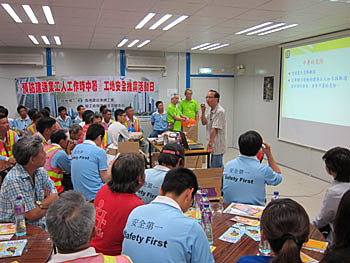
Under the Customer Service Teams Project, volunteers visited 18 855 catering establishments and SMEs of the wholesale and retail trade, business services and sanitary and similar services to disseminate safety messages to employers and employees in the year.
In 2010, we published 15 new occupational safety and health publications, including "A Guide to the Provisions for Excavations and Miscellaneous Safety under the Construction Sites (Safety) Regulations", "Safety Guide for Bamboo Scaffolding Work", "Occupational Safety and Health Statistics Bulletin Issue No. 10 (September 2010)", and booklets and leaflets for promoting health at work, e.g. "Hints on Occupational Health for Couriers - Manual Delivery Operations" and "Checklist for Risk Assessment of Outdoor Work under High Air Pollution Levels". Moreover, we also published publications in the languages of ethnic minorities for promoting to them work safety and health.
To promote the safety awareness of the industry in operating boilers and pressure vessels, we reviewed, revised and edited a number of publications, including the "Code of Practice for Owners of Boilers and Pressure Vessels", "Electrically Heated Boilers and their Operation", "Guide to Operation of Steam Receivers", "Brief Accident Cases of Boilers and Pressure Vessels in Hong Kong" and "A Guide for Fire-Tube Boiler Operation".
In 2010, the Occupational Safety and Health Branch handled 13 989 enquiries, advising on various safety and health matters. Furthermore, the Occupational Safety and Health Centre provides information and advisory services to workers and employers.
Clinical Occupational Health Services
The Labour Department runs occupational health clinics in Kwun Tong and Fanling, providing clinical consultations, medical treatment as well as occupational health education and counselling services for workers suffering from work-related and occupational diseases. The workplaces of the patients are inspected if necessary to identify and evaluate occupational health hazards in the work environment.
In 2010, 13 073 clinical consultations were rendered. Moreover, five patient support groups were organised to promote patients' compliance with treatment and sustainability in good work practices through health talks, experience sharing and peer support.
